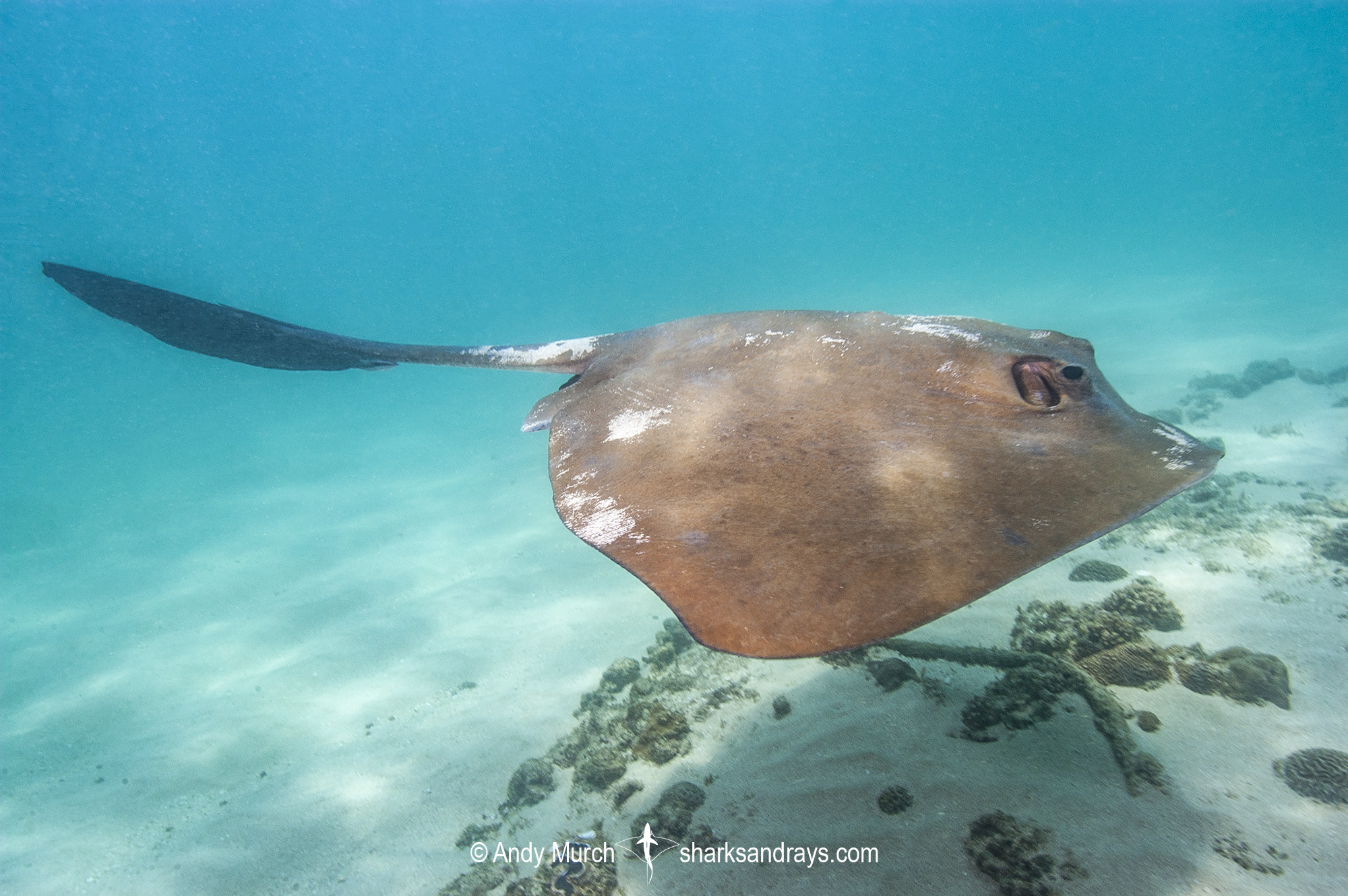Common name(s)
Broad Cowtail Stingray.
Identification
A medium-sized stingray with a kite-shaped disc that is slightly wider than long; disc width approximately 1.2-1.3 x length. Snout short and obtusely angular with a small protruding tip. Anterior margins of disc almost straight or mildly convex. Pectoral fin apices angular. Pelvic fins large with narrowly rounded apices.
Eyes small. Snout length 1.6-1.8 x combined eye and spiracle length. Mouth small and arched, with 5 oral papillae; 3 central papillae close together. Jaws bulbous. Nasal curtain skirt-shaped with a central split (bi-lobed). Nostrils thin, positioned obliquely.
Wide band of flattened denticles on central disc in adults. Up to 3 small seed-shaped thorns on midline at shoulder; often absent in adults or merged into denticle band. Tail fairly short, tapering gently to tail sting, then filamentous to tip. Tail length (when intact) usually less than 2x disc width. Dorsal finfold absent. Ventral finfold long and very deep; depth beyond caudal sting 3.5-4.8 x tail height. Ventral fold base length 0.77-0.98 x disc width. One caudal sting usually present; set well back on tail.
Colour
Dorsum yellow-brown to grey. Ventrum white, often with a thin dark margin. Tail beyond caudal sting usually dark. Ventral finfold bluish or black.
Size
Maximum disc width at least 89cm. Disc width at birth unknown.
Habitat
Tropical seas. On soft substrates, often adjacent to reefs. From shallow estuaries to at least 60m.
Distribution
Northwest Indian Ocean, Arabian Gulf, and Red Sea.
Conservation Status
LEAST CONCERN
Cowtail Rays are caught throughout the region, by trawl, gillnet and longline fishing. Inshore fishing pressure is intense and increasing in the region, particularly in India, Pakistan, and elsewhere. Cowtail Rays are landed and utilized in India, where ray landings have declined significantly. In contrast, they are generally released when caught in the Arabian Gulf/Persian Gulf (hereafter referred to as the ‘Gulf’) and the Red Sea, and although fishers often cut off the tail before release, rays without tails have been observed alive. In addition to fishing pressure, the loss and modification of coastal habitats in the Gulf is a significant concern for inshore species such as this. On the basis of intense and increasing fishing in coastal regions and high mortality in India, but a lack of retention in the Gulf and Red Sea, it is suspected that the regional population has undergone a population size reduction of close to 30% over the last three generation lengths (60 years). With ongoing fishing pressure and habitat degradation and loss, future population declines are suspected over the next three generations (2017-2077), and the Cowtail Ray is therefore assessed as Near Threatened (nearly meeting VU A2d+3d). Species-specific information on each Pastinachus species occurring in the region is needed to ascertain status more accurately.
Citation
Kyne, P.M., Jabado, R.W., Bineesh, K.K. & Spaet, J. 2017. Pastinachus sephen. The IUCN Red List of Threatened Species 2017: e.T70682503A109922153. https://dx.doi.org/10.2305/IUCN.UK.2017-2.RLTS.T70682503A109922153.en. Downloaded on 22 February 2021.
Reproduction
Matrotrophic aplacental viviparity. Litter size unknown.
Diet
Diet unknown.
Behavior
Sedentary. Behavior poorly known.
Reaction to divers
Shy but approachable if accustomed to divers.
Diving logistics
The range of the cowtail stingray is unclear due to confusion with other species in the Pastinachus genus but the holotype was described from the Red Sea. Dive sites in Egypt are probably the most likely place to find this species.
What’s new
View our full list of updates
Similar species
Broad Cowtail Stingray Distinguishable by 4 midline thorns (rather than 3), somewhat darker ventral finfold, and shorter tail filament.


